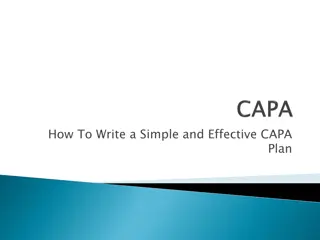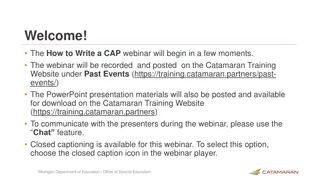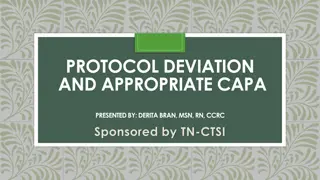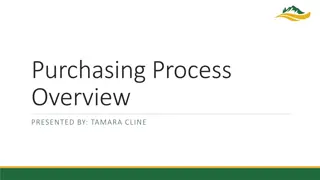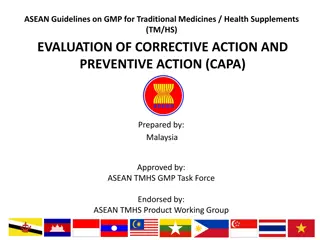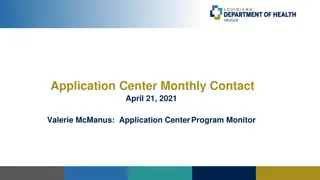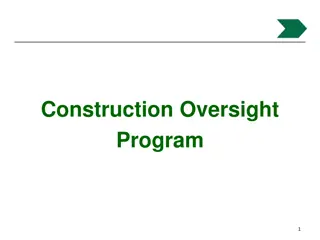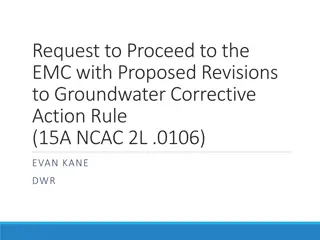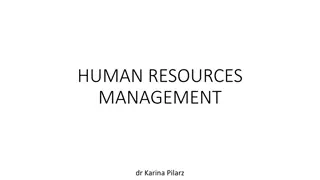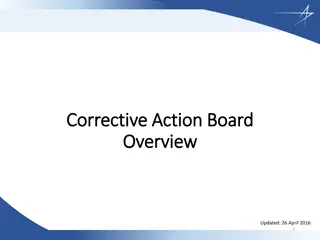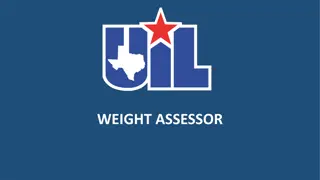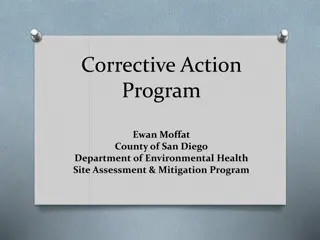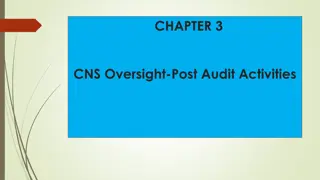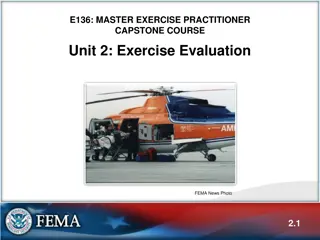DOELAP Assessor Training Corrective Actions
This content provides an overview of the DOELAP Assessor Training and Corrective Actions process, including roles, responsibilities, post-assessment actions, applicant responses to findings, and actions at the concern level. It covers how corrective actions are developed, reviewed, and implemented, as well as the responsibilities of assessors and applicant programs in addressing identified concerns. The process emphasizes the importance of effective corrective actions and documentation for accreditation purposes.
Download Presentation

Please find below an Image/Link to download the presentation.
The content on the website is provided AS IS for your information and personal use only. It may not be sold, licensed, or shared on other websites without obtaining consent from the author. Download presentation by click this link. If you encounter any issues during the download, it is possible that the publisher has removed the file from their server.
E N D
Presentation Transcript
DOELAP Assessor Training Corrective Actions Idaho Falls, ID September 2023
DOELAP Corrective Action General Process Overview Post Assessment Applicant program develops the CAs DOE field element concurs on the CAs CAs are forwarded to the STM by the cognizant field element STM receives and reviews the CAs May contact the assessors to verify the adequacy of the CAs Applicant program provides objective evidence to demonstrate the CAs were effectively implemented A follow-up assessment may be performed when necessary 2
DOELAP Assessor Role Assessor Responsibilities Perform assessment Evaluate the effectiveness of the implemented corrective action(s) Review documentations provided Report findings (Observation, Concern, Deficiency) Any recurrent Concern identified during the program s next accreditation cycle, irrespective of any corrective action implemented, will automatically may be elevated to a deficiency Conduct follow-ups 3
Post Assessment Actions Applicant Response to Findings Under most circumstances, the role of the assessor ends at this point. However, sometimes the STM, OSB, and/or Admin may contact the assessor(s) for further input, confirmation, or questions regarding the assessment. Applicant Program Reviews the assessment findings Findings at the observation level: No written response required by the assessed program Findings at the concern or deficiency level: Requires the assessed program to submit a CAP to the STM for approval Develops and submits official CAP response to STM Program s have the option to contest or appeal any reported findings 4
Post Assessment Actions Findings at the CONCERN Level Applicant Program Responsibilities CAP submitted to DOELAP STM within 45 days of the close-out meeting Complete all corrective actions within 1 year of the close-out meeting For corrective actions lasting longer than 1 year: Notify STM and appropriate DOE field element Provide a written justification for why the CA(s) were not completed within 1 year Evaluate the effectiveness of the corrective action Ensure documentation is available for review during next on-site assessment 5
Post Assessment Actions Findings at the DEFICIENCY Level * Results in the suspension of an application for accreditation * Applicant Program Responsibilities CAP submitted to STM within 45 days of the close-out meeting Complete all CAs within 60 days of the close-out meeting Evidence that CA has been completed must be received by the STM within 60 days of the close-out meeting to reactivate the suspended application CAs may be confirmed by a monitoring visit Evaluate the effectiveness of the CA Ensure documentation is available for review the next on-site assessment 6
Post Assessment Actions Findings at the DEFICIENCY Level Substantial deficiencies, as determined by the DOELAP Administrator, may result in the suspension or revocation of a programs current accreditation until all CAs are completed Substantial deficiencies may require a monitoring visit prior to resumption of DOELAP Accredited activities 7
Terminology Correction Corrective Action Root Cause Root Cause Analysis Corrective Action Plan 8
Correction vs. Corrective Action Difference between Correction and Corrective Action? Root Cause Analysis (RCA) 9
Correction vs. Corrective Action Correction The action taken to perform a fix of the immediate problem to resolve the nonconformity and make it acceptable (i.e., when you find a problem and fix the immediate problem) Quick, on-the-spot fix to a problem (act of containment) Does not take action to prevent the problem from recurring Band-Aid fix Corrections = Red Flag 10
Correction vs. Corrective Action Corrective Action (CA) The action taken to eliminate the cause(s) of existing nonconformities to prevent recurrence Evaluate and identify the underlying root cause(s) of a nonconformity and implement planned action(s) to correct the underlying root cause(s) and prevent recurrence CA process starts with RCA CAs are a result of a thorough root cause analysis process 11
Root Cause Determination Root Cause A factor that caused a nonconformance and should be permanently eliminated through corrective action or process improvement. The root cause is the core issue the highest-level cause that sets in motion the entire cause-and-effect reaction that ultimately leads to the problem(s). 12
Root Cause Determination The term root cause implies there is a single cause for a problem Commonly, multiple causes interact and work together to trigger the problem Thus, some CAPs may identify more than one true root cause 13
Common Root Causes Lack of or incomplete training Design of process Change in control/communication Inadequate SOPs Purchasing/supplier quality issues Neglected QC trends or outliers Lack of documentation Insufficient instrument maintenance Equipment malfunction or design 14
What is Root Cause Analysis? Root Cause Analysis An investigation that involves implementing analytical, problem-solving techniques to identify all potential cause(s) for the nonconformity. A collective term that describes a wide range of approaches, tools, and techniques used to uncover causes of problems. Revolves around the process of identifying the source of a problem and looking for a solution in a way that the problem is treated at the root level. The results of RCA are then used to formulate a CAP. The elimination of the symptoms of a problem is not alone sufficient to address the problem and prevent recurrence it must be addressed at the source. 15
Root Cause Analysis Tools Implementation of RCA Most methods are found to be fairly effective at reaching potential root causes if properly carried out. Common examples: 5 Whys Fishbone Diagrams (Cause-and-Effect) Tree diagrams Ideally, a combination of various tools and techniques should be used to conduct root cause analysis in your organization. 16
Root Cause Analysis Tools 5 Whys Considered the simplest approach to RCA. Problem statement: The electric water heater suddenly stopped working. Why did it stop? It was found that the circuit breaker was tripped. Why did the circuit breaker trip? The electric water heater was about to overheat. Why was the electric water heater about to overheat? A buildup of sediment was found around the heating elements. Why was the machine not checked and cleaned? There was a missed inspection and maintenance routine. Why was there a missed routine check? The assigned team member wasn t properly informed about the schedule. 17
Root Cause Analysis Other Approaches, Methodologies, and Techniques Events and causal factor analysis: Widely used for major, single-event problems; uses evidence gathered quickly and methodically to establish a timeline for the activities leading up to the accident. Once the timeline has been established, the causal and contributing factors can be identified. Change analysis: Applicable to situations where a system s performance has shifted significantly. It explores changes made in people, equipment, information, and more that may have contributed to the change in performance. Barrier analysis: Focuses on what controls are in place in the process to either prevent or detect a problem, and which might have failed. Management oversight and risk tree analysis: One aspect is the use of a tree diagram to look at what occurred and why it might have occurred. 18
Root Cause Analysis Other Approaches, Methodologies, and Techniques Pareto Analysis: Technique used to help prioritize potential causes by identifying the most common ones. Define, Measure, Analyze, Improve, Control (DMAIC): A data-driven strategy of an organization s Six Sigma quality initiative that s used in process improvement. Composed of relatively straightforward steps, with each step aiming to ensure the best results possible. Failure Modes and Effects Analysis (FMEA): Risk analysis tool that can help prioritize possible causes based on their potential impact. One of the most in-depth methods and is best applied to establish cause-and-effect relationships that aim to describe why specific issues occur. 19
Root Cause Analysis General Process 20
Root Cause Analysis Determining the true root cause is not always obvious Requires careful, thorough analysis and critical thinking of all potential causes of the problem Often the most difficult task but is fundamental for the CA process RCA can be conducted by a single person; however, the outcome is generally better when a group of people work together to find the causes of a problem. 21
Root Cause Analysis Common Issues or Mistakes The simplest, and most common, root cause analysis mistake is not to perform a root cause analysis. People tend to jump to conclusions and start with knee-jerk reactions based on assumptions. Likely the most common reaction when something goes wrong. Often leads to fixing the symptoms of a problem rather than the root cause. Examples include equipment failure, human error, customer complaint. Sometimes people go overboard with RCA by investigating problems that aren t worth investigating. Sometimes people start taking shortcuts to save time. 22
Root Cause Analysis Identifying the Root Cause(s) Not all root cause analysis will be effective the first time There may be more than one true root cause identified Avoid the identifying people or human error as the root cause People are generally not the ultimate cause of the problem Most people do not come to work planning to sabotage their own work 23
Root Cause Analysis Questions that may help to determine if your root cause appropriately addresses the problem not just the specific incident. Does the RCA simply restate the finding? Is the RCA a statement of correction? Does the RCA refer to the system or the incident? Does the RCA answer the following question: Why did the system or process breakdown occur? Have you identified the necessary corrective action that needs to be taken for the root cause identified? Does the identified root cause allow the problem to be turned on and off? 24
What is a Corrective Action Plan? Corrective Action Plan (CAP) A documented plan developed by the assessed program to address the nonconformity and communicate the program s plan of action which includes the identification of the true root cause(s) of the problem and the corrective actions intended to eliminate those cause(s). CAP may be a single plan of action or a step-by-step plan of action depending on the severity of the finding i.e., Corrective actions should be commensurate with the magnitude and risk of the problem 25
Goal of the Corrective Action Plan The goals of implementing a CAP to identify and address the true root cause(s) of a problem to permanently fix the problem and prevent its recurrence to eliminate nonconformities to improve processes or methods 26
Writing a Corrective Action Plan Staff responsible for writing the CAP should be familiar with the processes or areas of noncompliance identified CAP should be created with realistic corrective actions and timelines CA process should begin immediately after the on-site assessment CAP includes all DOELAP requested information 27
Effective Corrective Actions Adequately addresses the specific deficiency or concern Thorough root cause analysis was performed Did the lab look at other areas where similar problems may occur? Addresses system failures Includes the ongoing assessment of the effectiveness of CA s 28
Reasons for Poor Corrective Actions People start fixing problems before finding the problem s root causes Instinctive reaction is to try to fix it; fail to apply adequate RCA of the problem Don t systematically investigate the problem because they don t have a good understanding of the causes of the problem It s impossible to solve significant problems using the same level of knowledge that created them. - Albert Einstein Thought the problem was too simple to require formal RCA Misunderstanding of a true root cause Leads to corrections If they have already seen the effect before then they think they know the cause (same problem as last time). Tend to use the same CA for problems that may have different causes. 29
Examples of Poor Corrective Actions People find one or more root causes, but they still can t seem to fix the problem. So, they often revert to the Three Standard Corrective Actions to fix all problems. Discipline: This starts with the common corrective action, Counsel the employee to be more careful when Training: One of the most used (and misused) corrective action. Procedures: If you don t have one, write one. If you already have one, make it longer. Another example is the Re corrective actions. Re-train, Re-write, Re-mind, Re-emphasize, re-place, re-evaluate, re-qualify If it didn t work the first time, then why will it work this time? What caused the first training, procedure, part, rule, qualification, etc. to fail? 30
Corrective Action Plans Questions that may help to determine if your corrective action plan appropriately addresses the problem. Does the CAP address the root cause? Does it simply give correction? Does it address the system? Does it implement a change in the system or is it incident specific? Is there one corrective action for each identified root cause? Does data confirm that the problem is alleviated as a result of the corrective action? 31
RCA and CAP scenario Situation: It's 3 p.m. and you have a 5 p.m. deadline. You are hurriedly reviewing a lengthy procedure that needs to be amended and on the boss' desk by 5 p.m. when disaster strikes- the lens of your glasses falls out again! What do you do? Finding (Problem): Your glasses have broken several times within the last few weeks, which is slowing your productivity. 32
RCA and CAP scenario Finding (Problem): Your glasses have broken several times within the last few weeks, which is slowing your productivity. Bad Example: Containment: Use clear adhesive tape to secure the lens in the frame. Root Cause: The root cause of the finding is that the glasses keep breaking, causing me to miss deadlines. Corrective Action: Use clear adhesive tape to secure the lens in the frame, each time they break; ask boss for deadline extension. Why is this a poor example of RCA? Root cause listed is a symptom of the problem; it does not address the true problem in the system. The CAP is an act of containment, and the finding and the root cause are identical which provides no true value to the system. 33
RCA and CAP scenario Good Example: Short-Term Containment: Use clear adhesive tape to secure the lens in the frame. Root Cause Analysis: Methodology: 5-Why Restate the finding: The lens keeps falling out of my eyeglasses. 1st Why: Why does the lens keep falling out of your glasses? I store them in my desk drawer without a case and they sometimes get tossed around in the drawer amidst the other items that are strewn about. 2nd Why: Why are you not storing them in the case? I am not storing them in the case because I lost the case. 3rd Why: Why did you lose the case? My desk is extremely disorganized. Corrective Action: I will buy a new case and use it! I will organize my desk so that the glasses will no longer be smashed under the pressure of the other items in my desk. Since my desk will be organized, I will be able to store the glasses in their case in a clear area of your desk drawer when I don't need to wear them. 34
Purpose of DOELAP Corrective Action Plan Accountability Ensures the assessed program is held accountable for addressing their nonconformities and implementing corrective actions The assessed program is expected to monitor or follow-up on implemented corrective actions, evaluate and document their effectiveness at correcting the problem and preventing recurrence. Improve overall performance 35
DOELAP Corrective Action Plan CAP for DOELAP nonconformities should address the following: What are the corrective actions? Address the nonconformity Who is responsible for the implementing the various aspects of the CAP? Likely involves multiple personnel When (date) is the corrective action planned to be completed? Projected timeline for completing CA How will ongoing compliance be maintained? Follow ups Monitor implemented CA Evaluate results of implemented CA for effectiveness 36
Corrective Action Follow Up DOELAP Assessors Check on status of CAs from previous assessments Verify all CA s have been effectively implemented as documented Evidence of RCA applied for CA processes Verify the program is monitoring the results of implemented CA(s) for effectiveness and completeness Verify all required documentation is provided and satisfactory Note the closure of finding(s) in assessment report If CA implemented differs from submitted CAP find out why STM is available to provide assistance and answer questions 37
Corrective Action Plan Example: Finding #1 Finding #1 Concern (1): The standard operating procedure XYZ-003, Rev. 21, Assessment, Preventive Action, Corrective Action, and Nonconformance Reporting, dated March 05, 2015, has not been updated or revised since 2015. Section 3 states the SOP to be reviewed and revised every five years. 4.4 (b) and 4.5 (a). Rated as a Concern References the requirement, provides supporting evidence of nonconformity 38
Correction Action Plan Example: Concern #1 Submitted Response to Concern Revise XYZ-003, Rev. 21, Assessment, Preventive Action, Corrective Action, and Nonconformance as necessary. Revise section 3 of the SOP to state three-year review cycle. Estimated completion date: 6/15/2022. CAP response is more of a correction than corrective action lacks evidence of RCA revise section 3 of the SOP to state a three-year cycle. How will this be achieved? What is the process? Who is responsible for what? This process appears to already be in place, why did it fail? What is the root cause? How can we expect this CAP to effectively correct and prevent the problem from recurring? 39
Corrective Action Plan Example: Finding #2 Finding #2: Concern #1 - All of the procedures provided to the assessment team were currently up-to-date and reviewed. However, several procedures were discovered to have been reissued after exceeding the three-year review cycle timeframe as stated within the requirements of the Quality Assurance Plan. This appears to be a recurring issue. A concern on the 2017 onsite assessment found that eight procedures were not updated within the previously stated two- year review cycle timeframe. This concern was considered closed in 2021 during the Quality Review for Programs in Good Standing with the procedures being revised and officially reissued. However, these previously implemented corrective actions do not seem to have been effective in resolving this issue and do not adhere to the criteria in 4.4(b). 40
Corrective Action Plan Example: Finding #2 Proposed Corrective Action C1a Analytical Services and Instrumentation (AS&I) and Technical Services Department (TSD) Management have agreed to provide additional administrative support to assist with the performance and coordination of the procedure review and revision process. Assistance may include: Maintaining a procedure tracking index/log and procedure revision schedule. Providing review and revision notifications to AS&I personnel and management. Ensuring the final procedures are properly formatted and updated with information provided by technical staff. Obtaining the appropriate procedure signatures. Electronically distributing, posting, and controlling the documents for user access. Proposed Corrective Action C1b Procedure review dates may be adjusted to reduce the need to review and reissue multiple procedures at the same time. However, the review reissue dates shall not be extended past the review cycle timeframe as specified in the Radioanalytical Laboratories Quality Assurance Plan (i.e., the procedure reissue date may not be extended past 3 years from the current issue date). Proposed Completion Date: 7/1/2024 41
Questions? 42








